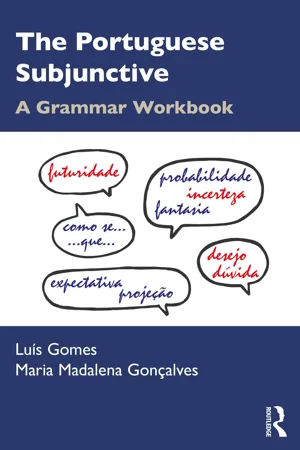
- 138 pages
- English
- ePUB (mobile friendly)
- Available on iOS & Android
About This Book
The Portuguese Subjunctive: A Grammar Workbook is the first book devoted exclusively to understanding and mastering this challenging area of Portuguese grammar.
The clear structure guides students through the six subjunctive tenses, providing them with concise and accurate explanations accompanied by a range of exercises to test and consolidate learning. Each chapter is designed to help students progress from simple to more complex use of the language, with instructions initially set in English before moving to Portuguese, and exercises progressing from simple application to more advanced translation and 'compare and contrast' tasks.
This grammar workbook is ideal for intermediate to advanced learners of European or Brazilian Portuguese who wish to master the use of the subjunctive. It can be used as a supplementary in-class text as well as a resource for independent study.
Frequently asked questions
Information
PART IThe simple tenses of the subjunctive
1THE PRESENT SUBJUNCTIVE
1.1 Morphology
1.1.1 Forming the present subjunctive
| Verbs ending in — AR | Verbs ending in — ER/OR1 and — IR | |
|---|---|---|
| eu | —e | —a |
| tu | —es | —as |
| você, ele, ela | —e | —a |
| nós | —emos | —amos |
| vocês, eles, elas | —em | —am |
1.1.2 The regular present subjunctive
| —AR | —ER/ÔR | —IR | |
|---|---|---|---|
| CANTAR | CORRER | ABRIR | |
| eu | cantE | corrA | abrA |
| tu | cantES | corrAS | abrAS |
| você, ele, ela | cantE | corrA | abrA |
| nós | cantEMOS | corrAMOS | abrAMOS |
| vocês, eles, elas | cantEM | corrAM | abrAM |
1.1.3 The irregular present subjunctive
| Verb | eu | tu | você, ele, ela | nós | vocês, eles, elas |
|---|---|---|---|---|---|
| CABER | caiba | caibas | caiba | caibamos | caibam |
| DAR | dê | dês | dê | demos | deem |
| DIZER | diga | digas | diga | digamos | digam |
| DORMIR | durma | durmas | durma | durmamos | durmam |
| ESTAR | esteja | estejas | esteja | estejamos | estejam |
| FAZER | faça | faças | faça | façamos | façam |
| HAVER | — | — | haja | — | — |
| IR | vá | vás | vá | vamos | vão |
| LER | leia | leias | leia | leiamos | leiam |
| OUVIR | ouça | ouças | ouça | ouçamos | ouçam |
| PASSEAR2 | passeie | passeies | passeie | passeemos | passeiem |
| PEDIR | peça | peças | peça | peçamos | peçam |
| PERDER | perca | percas | perca | percamos | percam |
| PODER | possa | possas | possa | possamos | possam |
| PÔR | ponha | ponhas | ponha | ponhamos | ponham |
| QUERER | queira | queiras | queira | queiramos | queiram |
| SABER | saiba | saibas | saiba | saibamos | saibam |
| SEGUIR | siga | sigas | siga | sigamos | sigam |
| SENTIR | sinta | sintas | sinta | sintamos | sintam |
| SER | seja | sejas | seja | sejamos | sejam |
| TER | tenha | tenhas | tenha | tenhamos | tenham |
| TRAZER | traga | tragas | traga | tragamos | tragam |
| VER | veja | vejas | veja | vejamos | vejam |
| VIR | venha | venhas | venha | venhamos | venham |
1.1.4 Spelling changing stems
- to preserve the [g] sound
- /gar/ > /go/ > /gue/3 pagar > pago > pague
- /guir/ > /go/ > /ga/ conseguir >consigo > consiga
- to preserve the [s] sound
- /çar/ > /ço/ > /ce/ dançar > danço > dance
- /cer/ > /ço/ > /ça/ descer > desço > desça
- to preserve the [3]4 sound
- /gir/ > /jo/ > /ja/ dirigir > dirijo > dirija
- to preserve the [k] sound
- /car/ > /co/ > /que/5 tocar > toco > toque
1.2 Using the present subjunctive
1.2.1 Independent clauses
- Expressing doubt:
- Example: Talvez vá ao cinema amanhã.
- Expressing admiration or a strong desire in formulaic expressions:
- Example:
- Tomara que eles chegue...
- Example:
Table of contents
- Cover
- Half Title
- Title Page
- Copyright Page
- Table of Contents
- Foreword
- Acknowledgements
- Preliminary chapter
- PART I The simple tenses of the subjunctive
- PART II The perfect tenses of the subjunctive
- Answer key
- Appendix: Present subjunctive spelling changes
- Bibliography
- Index